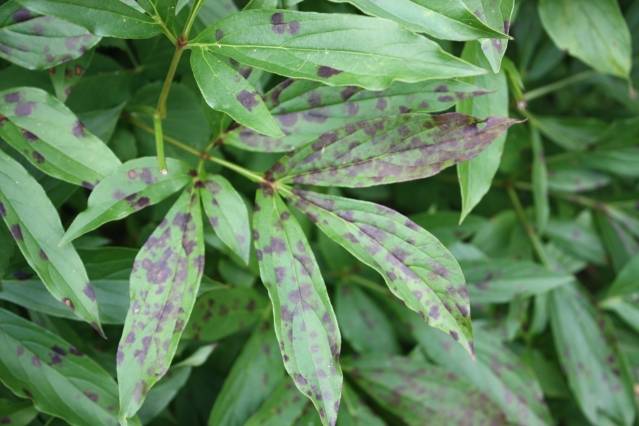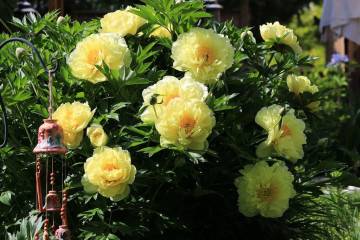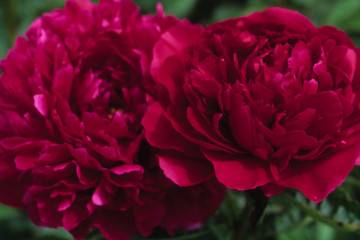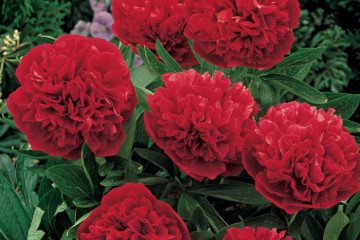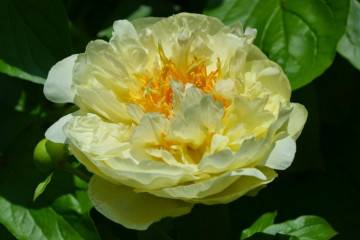Peony Sorbet (Paeonia Sorbet) - cultivation in the garden
Content:
Peony Sorbet is an unpretentious herb that has a laconic appearance and a rich aroma. The culture is characterized by graceful buds that can be used to create floristic compositions.
Peony Sorbet (Paeonia Sorbet) - what is this variety, history of creation
This hybrid variety was developed in Holland. It looks great in bouquets and can serve as a decoration for any flower bed.
Brief description of peony Sorbet
This culture is characterized by powerful shoots that can reach a height of 1 m. The plant belongs to the category of lactic-flowered crops. Despite its impressive size, it is considered herbaceous.
Peonies are characterized by branched stems and delicate leaves, which are divided into narrow fragments. With the arrival of autumn, the foliage turns crimson.
Flowers of this variety are large in size. Terry inflorescences are characterized by an original structure and can reach 16 cm in diameter. Each row of flowers has its own color. At the same time, pale pink alternates with milky. Therefore, peonies are often called three-layer. They have concave petals and a pleasant scent.
Sorbet peony begins to bloom in the first half of June. The culture is characterized by rather powerful shoots that can withstand large buds. The plant does not require tying. At the same time, flower growers often use supports so that the bush does not disintegrate.
Advantages and disadvantages of the variety
Herbaceous peony Sorbet has many advantages:
- excellent decorative properties;
- sophisticated aroma;
- the ability to use for decoration of flower beds and lawns;
- high frost resistance.
At the same time, the plant also has certain disadvantages. It is very demanding on the composition of the soil. In addition, the culture can be affected by fungal infections and various pests.
Use in landscape design
Peony Sherbet is considered a fairly hardy crop. Therefore, the plant is often used to decorate city gardens and parks. Compact bushes look attractive near buildings and water bodies. From them you can make a hedge, which helps to zone the site.
Dark green bushes look good with other ornamental plants. They can be combined with small conifers, small-flowered plants. It is also permissible to plant peonies in the central part of a round flower bed.
After flowering, the beautiful foliage of peonies becomes an excellent backdrop for other crops. Sage, irises, asters are suitable as additions to peonies. Thuja and barberry look good with them.
Growing a flower, how to plant it in open ground
To succeed in growing a crop, you need to pay attention to planting.
Planting by root cuttings
Planting should be done immediately after dividing the root or purchasing a seedling. It is important to carefully examine the seed. It must not show any signs of rot or stains. In this case, the plant should contain from 3 to 5 live buds.
What time is the boarding
It is recommended to plant a peony of this variety in the first half of autumn, so that the plant has time to take root before frost.
Location selection
A peony needs a well-lit area. It is best to keep the bush in direct sunlight throughout the day.
How to prepare the soil and flower for planting
The culture needs a slightly acidic and fertile soil. It should have a loose structure. If necessary, sand or peat is added to the ground. The pH parameters should be 6-6.5.
At the stage of preparation, you need to make holes 50 cm in size. They are dug at intervals of 1 m. A drainage layer should be placed at the bottom of the depression. The seedlings must be soaked in a biostimulant solution.
Planting procedure step by step
You need to plant peonies according to the following scheme:
- Pour a mixture of compost and humus into the prepared recesses.
- After a week, plant the plant, deepening the upper bud by 5 cm.
- Water the culture abundantly.
- Cover the bed with a mulch layer. For this, dry leaves, peat, sawdust are used.
Seed planting
Only breeders can propagate peonies by seeds. This is a rather complicated and time-consuming method. At the same time, the seeds are distinguished by low germination. It is no more than 10%.
Plant care
In order for a plant to grow and develop normally, it needs to be provided with full and high-quality care.
Watering and feeding
The plant needs to be watered infrequently, but abundantly. Pour 2-3 buckets of water under the bush. Thanks to this, the liquid will be able to penetrate the entire length of the roots.
Timely fertilization is of no small importance. Systematic feeding prolongs flowering and makes the culture more decorative.
Mulching and loosening
To maintain the desired level of moisture in the soil and to avoid the development of weeds, the beds are covered with a mulch layer. It can consist of sawdust or peat. After each watering, the beds need to be loosened.
Preventive treatment
The plant can face pest attacks and the development of diseases. Therefore, before flowering, peonies should be sprayed with insecticides and fungicides. Also, for preventive purposes, you can use folk remedies.
Blooming peony Sherbet
This variety is distinguished by its lush and abundant flowering. Due to this, the culture is often used for decorative purposes.
A period of activity and rest
The flowering culture begins in the first half of June and lasts a long time. With the arrival of cold weather, peonies have a dormant period.
Care during and after flowering
During the period of bud formation, the bushes need phosphorus-potassium fertilizers. To do this, use nitrophosphate or superphosphate. When the flowers open, it is better to use complex mineral preparations.
What to do if it does not bloom, possible reasons
In the absence of flowers, it is necessary to make adjustments to the care of the crop. The most likely reasons for the lack of flowering include:
- lack of dressing;
- lack of solar lighting;
- planting crops in infertile soil;
- violation of the irrigation regime;
- infection with diseases;
- pest attacks.
Peonies after flowering
After the end of the flowering period, peonies also need special care.
Transfer
The plant is characterized by rapid growth of roots. They can go 1 m deep. Therefore, replanting the culture is very problematic. It is recommended to do this every 5-6 years.
Pruning
With the arrival of cold weather, the shoots of the plant must be cut off almost to the very surface of the earth. This will provide the culture with a good wintering period.
Preparing for winter
The plant has excellent frost resistance. However, in regions with harsh climates, the beds can be covered with mulching materials.
Diseases, pests and ways to control them
The culture can be affected by fungal infections. Most often, gray rot or powdery mildew develops. In this case, fungicidal preparations should be used. When attacking pests, it is worth using insecticides.
Peonies are distinguished by excellent decorative properties, therefore they are very actively used to decorate garden plots. Sorbet is considered one of the most popular varieties that does not require specific maintenance.




